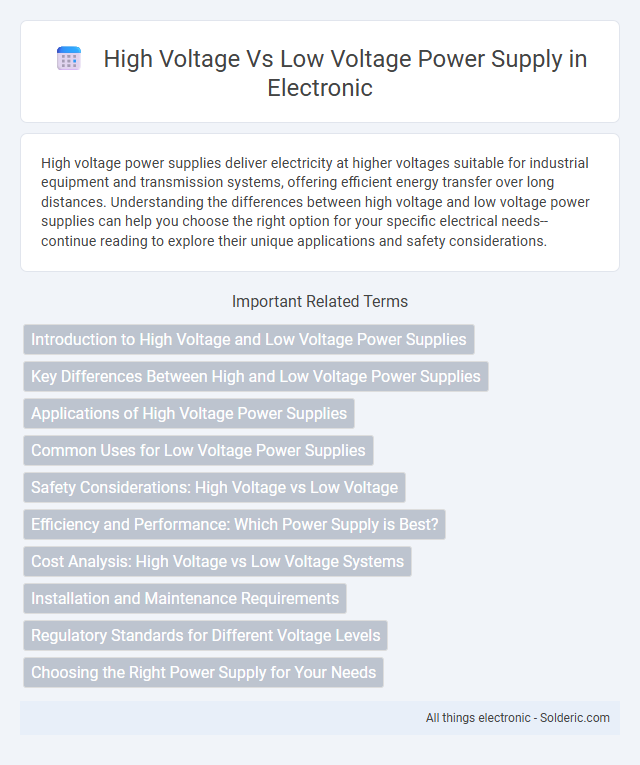High voltage power supplies deliver electricity at higher voltages suitable for industrial equipment and transmission systems, offering efficient energy transfer over long distances. Understanding the differences between high voltage and low voltage power supplies can help you choose the right option for your specific electrical needs--continue reading to explore their unique applications and safety considerations.
Comparison Table
| Aspect | High Voltage Power Supply | Low Voltage Power Supply |
|---|---|---|
| Voltage Range | > 1000 V | < 1000 V |
| Applications | Industrial machinery, X-ray machines, power transmission | Consumer electronics, LED lighting, small appliances |
| Safety | Requires strict insulation and safety protocols | Generally safer with standard insulation |
| Size and Cost | Larger, more expensive | Smaller, cost-effective |
| Efficiency | High efficiency in transmission over long distances | Efficient for low power applications |
| Current | Typically lower current levels | Higher current levels possible |
Introduction to High Voltage and Low Voltage Power Supplies
High voltage power supplies deliver electrical energy at voltages typically above 1000 volts, essential for applications such as industrial equipment, medical devices, and particle accelerators. Low voltage power supplies operate at voltages below 50 volts, commonly used in consumer electronics, telecommunications, and battery charging systems. Both types ensure efficient energy conversion tailored to the specific voltage requirements of diverse technological and industrial applications.
Key Differences Between High and Low Voltage Power Supplies
High voltage power supplies deliver electrical energy at voltages typically above 1000 volts, making them essential for industrial applications, medical devices, and scientific research requiring significant power levels. Low voltage power supplies operate below this threshold, providing safer, more manageable voltages ideal for consumer electronics, automotive systems, and communication devices. Understanding the voltage range, power capacity, insulation requirements, and usage scenarios helps you select the right power supply tailored to your specific application needs.
Applications of High Voltage Power Supplies
High voltage power supplies are essential in applications requiring the generation and control of electrical fields, such as X-ray machines, particle accelerators, and industrial electrostatic processes. They enable efficient operation in medical imaging, semiconductor manufacturing, and electrical insulation testing by providing stable and precise high voltage output. These power supplies also play a crucial role in scientific research, including plasma generation and ion implantation technologies.
Common Uses for Low Voltage Power Supplies
Low voltage power supplies are commonly used in electronics such as computers, LED lighting, and telecommunications equipment where safe, efficient energy delivery is essential. These supplies typically operate below 50 volts, minimizing electrical hazards and enabling use in sensitive circuits and portable devices. Their widespread application includes powering microcontrollers, sensors, and small household appliances that require stable, low-risk power sources.
Safety Considerations: High Voltage vs Low Voltage
High voltage power supplies pose significant safety risks due to their potential to cause severe electric shock, arc flash, and fatal injuries, necessitating stringent insulation, grounding, and protective equipment measures. Low voltage power supplies, while generally safer and reducing the risk of shock, still require careful handling to prevent burns, short circuits, and equipment damage. Your choice between high voltage and low voltage power supplies should prioritize proper safety protocols, risk assessments, and compliance with electrical safety standards to protect both personnel and equipment.
Efficiency and Performance: Which Power Supply is Best?
High voltage power supplies typically offer greater efficiency for long-distance energy transmission by reducing current loss and heat generation, enhancing overall system performance. Low voltage power supplies provide safer installation and are ideal for short-distance applications with high current demands, ensuring stable output and lower risk. Your choice depends on application needs, balancing efficiency with safety and operational requirements.
Cost Analysis: High Voltage vs Low Voltage Systems
High voltage power supply systems generally incur higher initial costs due to specialized insulation, safety equipment, and complex installation requirements, while low voltage systems offer lower upfront expenses and simpler infrastructure. Maintenance costs for high voltage systems can exceed those of low voltage systems because of stricter safety standards and the need for regular inspections to prevent insulation degradation. However, high voltage systems provide better energy efficiency over long distances, potentially reducing operational costs compared to low voltage setups in large-scale industrial applications.
Installation and Maintenance Requirements
High voltage power supplies require specialized installation procedures, including insulated tools, expert technicians, and strict compliance with safety regulations to prevent electrical hazards. Maintenance involves routine inspections of insulation integrity, grounding systems, and protective devices to ensure operational safety and reliability. Low voltage power supplies are easier to install and maintain, often requiring basic electrical knowledge, standard tools, and less stringent safety measures, making them suitable for residential and small commercial applications.
Regulatory Standards for Different Voltage Levels
Regulatory standards for high voltage power supplies typically include strict compliance with IEC 60664 for insulation coordination and IEEE C37 for high-voltage switchgear, ensuring safety and reliability in electrical systems above 1,000 volts. Low voltage power supplies, generally classified under 50 to 1,000 volts, must adhere to standards such as IEC 60950 for information technology equipment and UL 508 for industrial control equipment to guarantee consumer safety and electromagnetic compatibility. These voltage-specific regulations define insulation requirements, clearance distances, and testing protocols to mitigate risks associated with electrical hazards and maintain operational integrity.
Choosing the Right Power Supply for Your Needs
Choosing the right power supply depends on the application's voltage and current requirements, where high voltage power supplies deliver greater potential differences suitable for industrial equipment, scientific instrumentation, and specialized electronics. Low voltage power supplies are ideal for consumer electronics, low-power devices, and sensitive components that require stable and precise voltage outputs under safer operating conditions. Evaluating factors such as output voltage range, current capacity, efficiency, and regulatory compliance ensures optimal performance and safety in your specific use case.
High Voltage vs Low Voltage Power Supply Infographic

 solderic.com
solderic.com